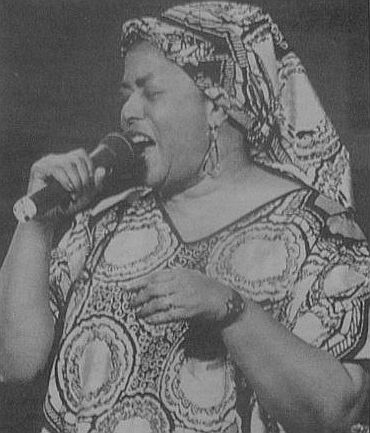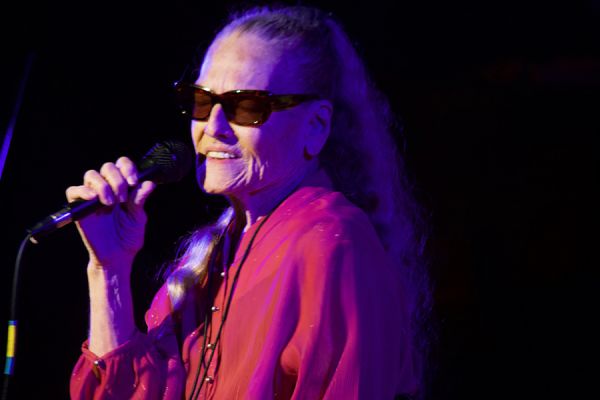During more than thirty years on the Portland jazz scene, singer and bassist Marianne Mayfield was a rare female instrumentalist in a male-dominated jazz world and was proud of her place in it. “I’m grateful for…the fact that I have enjoyed the respect of my contemporaries, the musicians, the guys. Not as a woman but as a musician and as a person,” she said in a 1985 interview. She also faced obstacles as an African American entertainer. When she started performing in the early 1950s, she couldn’t enter through the venue’s front door nor could her mother sit in the audience.
Mayfield's nurturing personality made her a beloved figure among local jazz musicians, according to drummer Mel Brown, who worked with her at The Mural Room in 1961. “I’d have to go back to the kitchen between sets,” recalled Brown, who was underage at the time, “and she’d come in, check my homework and buy me a hamburger." She became “everybody’s surrogate mother,” according to the Oregonian’s pop music critic, Marty Hughley. “She loved everybody," said Portland drummer Ron Steen, "and you could tell by who came to see her play; there’d be folks from the ghetto and folks from Lake Oswego.”
A native of Fresno, California, Mayfield grew up in Oakland, where she was in contact with other young players, including saxophonist Sonny King, who later worked in the Eugene and Portland areas and married vocalist Nancy King. Mayfield began playing the double bass in grade school. She played for a short time for the Oakland Symphony and was a substitute in the San Francisco Symphony while still a teenager. Later, based in Los Angeles, she accompanied blues star T Bone Walker.
Mayfield was touring with an all-woman vocal harmony trio called The Three V’s when she came to Portland, where she met her first husband and had a child. She didn’t leave until she retired and moved to Hawaii in 1993. In the mid-1960s, she was a member of the Julian Henson Trio and was later a singer with the Woody Hite Big Band.
Beginning in the late 1970s, Mayfield led her own groups in Portland nightclubs that included Parchman Farm, the Prima Donna, the Jazz Quarry, and the Village Jazz. She appeared at the Cathedral Park Jazz Festival and the Waterfront Blues Festival, and in 1991 her performance at the PDX Jazz Summit was televised by Oregon Public Broadcasting. In 1994, she released the CD, Close Your Eyes.
In addition to her career in music, Mayfield was a fifth grade teacher at Glenhaven and Jason Lee schools. She had put herself through college playing at night and had earned her bachelor’s degree and teaching certificate from Portland State University in 1972. She also served as a member of the Metropolitan Arts Commission. In 1982, she married Ray Hill. In 2001, Mayfield returned from Hawaii to live in Springfield, Oregon. She died of liver cancer at her home on October 20, 2004.
Two months before her death, the Mt. Hood Jazz Festival presented a tribute to Mayfield, featuring several area singers who had been influenced by her, including Marilyn Keller and Shirley Nanette.
-
![]()
Marianne Mayfield.
Courtesy Bob Church -
![]()
Marianne Mayfield, 1987, Parchman Farms.
Courtesy Portland Oregonian
Related Entries
-
![Esperanza Spalding (1984-)]()
Esperanza Spalding (1984-)
Esperanza Spalding’s fierce talent in double bass and vocal work earned…
-
![Nancy King (1940-2025)]()
Nancy King (1940-2025)
For most of her career, Nancy King has been considered the Pacific Nort…
Map This on the Oregon History WayFinder
The Oregon History Wayfinder is an interactive map that identifies significant places, people, and events in Oregon history.
Further Reading
Dietsche, Robert. Jumptown: Portland Jazz, 1942-1957. Corvallis: Oregon State University Press, 2005.
Hughley, Marty. "Mayfield, A Luminary of Local Jazz." The Oregonian, Oct. 24, 2004.
Lee, Deborah. "Working Women: Jeannie Hoffman and Marianne Mayfield." Jazzscene (Jan. 1985).




